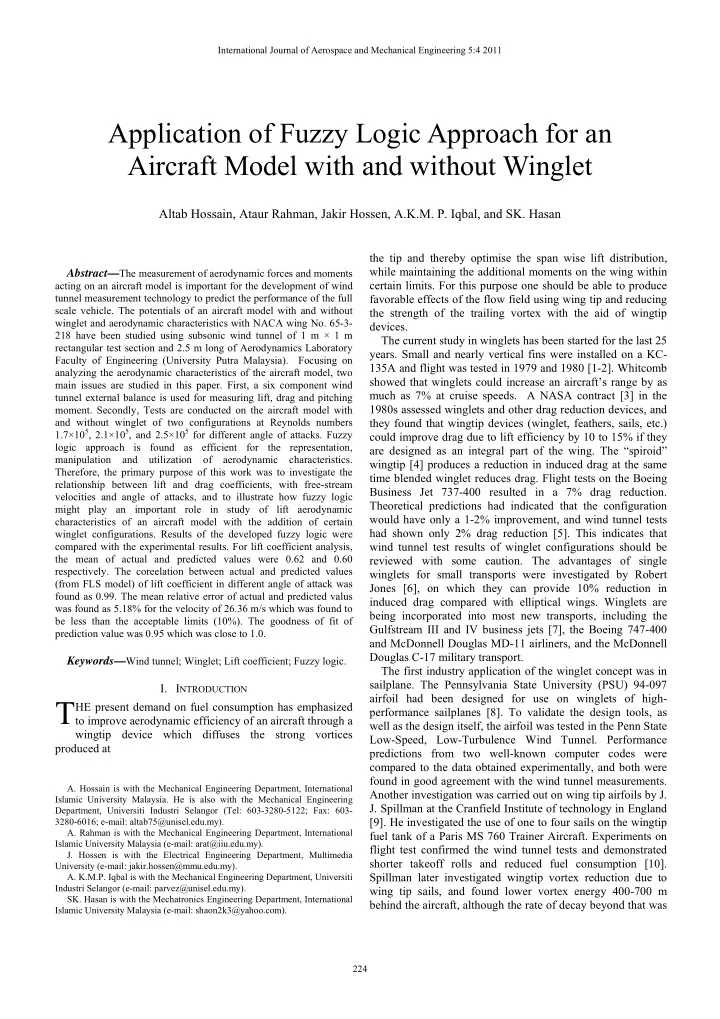

International Journal of Aerospace and Mechanical Engineering 5:4 2011 Application of Fuzzy Logic Approach for an Aircraft Model with and without Winglet Altab Hossain, Ataur Rahman, Jakir Hossen, A.K.M. P. Iqbal, and SK. Hasan the tip and thereby optimise the span wise lift distribution, while maintaining the additional moments on the wing within Abstract — The measurement of aerodynamic forces and moments certain limits. For this purpose one should be able to produce acting on an aircraft model is important for the development of wind tunnel measurement technology to predict the performance of the full favorable effects of the flow field using wing tip and reducing scale vehicle. The potentials of an aircraft model with and without the strength of the trailing vortex with the aid of wingtip winglet and aerodynamic characteristics with NACA wing No. 65-3- devices. 218 have been studied using subsonic wind tunnel of 1 m × 1 m The current study in winglets has been started for the last 25 rectangular test section and 2.5 m long of Aerodynamics Laboratory years. Small and nearly vertical fins were installed on a KC- Faculty of Engineering (University Putra Malaysia). Focusing on 135A and flight was tested in 1979 and 1980 [1-2]. Whitcomb analyzing the aerodynamic characteristics of the aircraft model, two showed that winglets could increase an aircraft’s range by as main issues are studied in this paper. First, a six component wind much as 7% at cruise speeds. A NASA contract [3] in the tunnel external balance is used for measuring lift, drag and pitching 1980s assessed winglets and other drag reduction devices, and moment. Secondly, Tests are conducted on the aircraft model with and without winglet of two configurations at Reynolds numbers they found that wingtip devices (winglet, feathers, sails, etc.) 1.7×10 5 , 2.1×10 5 , and 2.5×10 5 for different angle of attacks. Fuzzy could improve drag due to lift efficiency by 10 to 15% if they logic approach is found as efficient for the representation, are designed as an integral part of the wing. The “spiroid” manipulation and utilization of aerodynamic characteristics. wingtip [4] produces a reduction in induced drag at the same Therefore, the primary purpose of this work was to investigate the time blended winglet reduces drag. Flight tests on the Boeing relationship between lift and drag coefficients, with free-stream Business Jet 737-400 resulted in a 7% drag reduction. velocities and angle of attacks, and to illustrate how fuzzy logic Theoretical predictions had indicated that the configuration might play an important role in study of lift aerodynamic would have only a 1-2% improvement, and wind tunnel tests characteristics of an aircraft model with the addition of certain had shown only 2% drag reduction [5]. This indicates that winglet configurations. Results of the developed fuzzy logic were compared with the experimental results. For lift coefficient analysis, wind tunnel test results of winglet configurations should be the mean of actual and predicted values were 0.62 and 0.60 reviewed with some caution. The advantages of single respectively. The coreelation between actual and predicted values winglets for small transports were investigated by Robert (from FLS model) of lift coefficient in different angle of attack was Jones [6], on which they can provide 10% reduction in found as 0.99. The mean relative error of actual and predicted valus induced drag compared with elliptical wings. Winglets are was found as 5.18% for the velocity of 26.36 m/s which was found to being incorporated into most new transports, including the be less than the acceptable limits (10%). The goodness of fit of Gulfstream III and IV business jets [7], the Boeing 747-400 prediction value was 0.95 which was close to 1.0. and McDonnell Douglas MD-11 airliners, and the McDonnell Douglas C-17 military transport. Keywords — Wind tunnel; Winglet; Lift coefficient; Fuzzy logic. The first industry application of the winglet concept was in sailplane. The Pennsylvania State University (PSU) 94-097 I. I NTRODUCTION airfoil had been designed for use on winglets of high- T HE present demand on fuel consumption has emphasized performance sailplanes [8]. To validate the design tools, as to improve aerodynamic efficiency of an aircraft through a well as the design itself, the airfoil was tested in the Penn State wingtip device which diffuses the strong vortices Low-Speed, Low-Turbulence Wind Tunnel. Performance produced at predictions from two well-known computer codes were compared to the data obtained experimentally, and both were found in good agreement with the wind tunnel measurements. A. Hossain is with the Mechanical Engineering Department, International Another investigation was carried out on wing tip airfoils by J. Islamic University Malaysia. He is also with the Mechanical Engineering J. Spillman at the Cranfield Institute of technology in England Department, Universiti Industri Selangor (Tel: 603-3280-5122; Fax: 603- 3280-6016; e-mail: altab75@unisel.edu.my). [9]. He investigated the use of one to four sails on the wingtip A. Rahman is with the Mechanical Engineering Department, International fuel tank of a Paris MS 760 Trainer Aircraft. Experiments on Islamic University Malaysia (e-mail: arat@iiu.edu.my). flight test confirmed the wind tunnel tests and demonstrated J. Hossen is with the Electrical Engineering Department, Multimedia shorter takeoff rolls and reduced fuel consumption [10]. University (e-mail: jakir.hossen@mmu.edu.my). Spillman later investigated wingtip vortex reduction due to A. K.M.P. Iqbal is with the Mechanical Engineering Department, Universiti Industri Selangor (e-mail: parvez@unisel.edu.my). wing tip sails, and found lower vortex energy 400-700 m SK. Hasan is with the Mechatronics Engineering Department, International behind the aircraft, although the rate of decay beyond that was Islamic University Malaysia (e-mail: shaon2k3@yahoo.com). 224
Recommend
More recommend